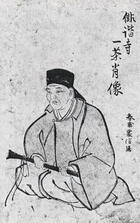
It was the spring of 1763 in the city of Kashiwabara, in the former Japanese province of Shinano. His family was engaged in agriculture, something common in eighteenth-century feudal Japan.
When he was a few years old, his mother passed away. She became in charge of his grandmother and it was then that the little boy was introduced to haiku for the first time, by the hand of a village poet named Shinpo. However, his father was soon remarried, an unhappy marriage. The problems with his stepmother did not take long to appear, and neither did the beatings: Yataro would remember having been beaten "more than 100 times in one night." The situation became even more unbearable when his stepmother gave birth to her half-brother.
At the age of 14 he went to Edo, present-day Tokyo, sent by his father.
We know that it was there that he resumed contact with the haiku. His days alternated between his work in a Buddhist temple and his studies with the poets Mizoguchi Sogan and Norokuan Chikua, at the Katsushika haiku school. His talent soon came to light and Seibi Natsume became his patron.
At that time Issa did not yet exist. His poems were signed with the pseudonyms Kobayashi Ikyo or Nirokuan Kikumei. It was in 1792 when he definitively abandoned the name of Yataro and adopted the literary name of Issa. "With spring / Yataro was reborn / turned into Issa," reads one of his haikus.
Following a tour of southwestern Japan in 1795, Issa published his Tabishui book of poems.
In later years he lived in different cities, he got to know the legendary Kyoto, Osaka, Matsuyama, Nagasaki and many others. But while his fame as a poet grew, Issa knew poverty for many years. Years in which he was forced to work hard and make frequent trips. He even returned to his native land sometime.
There, in Kashiwabara, his father died of typhoid fever. The problems arose again with his stepmother and his stepbrother, who prevented him for 13 years from inheriting the properties that his father always wanted them to be for him. In the Diary of the death of my father (1801) he recounts the lawsuits and the details of his father's illness. He says of him that, despite the disease that devoured him, "he smiled joyfully at everyone who offered him poison, and despised anyone who forced him to take medicine." The body was cremated in accordance with Buddhist rites, and Issa kept the bones from it.
At the beginning of 1810 he decided to settle permanently in Kashiwabara and married a young woman from the town. He was already 50 years old but a happy retirement did not await him; on the contrary, that was the most terrible period of his life. In the following 10 years he saw his 4 children die, and also his wife in childbirth of the last of them. He remarried, now 62 years old, but divorced after a few months. He still married for the third time. Then his house caught fire, and he returned to utter poverty.
The last months of his life were spent in a warehouse with a dirt floor. He died in the winter of 1827, never seeing the birth of his last daughter.








